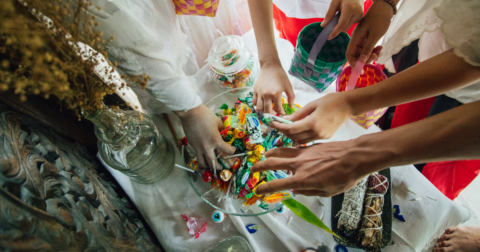Feature
Maine Was First to Ban Spreading PFAS-Contaminated Sludge on Farmland. Now Sludge Is Filling up Landfills.
Health•19 min read
Explainer
Derived from boiled pig and cow tissue and bones, gelatin is an ingredient in some, but not all, Halloween candy.


Words by Jessica Scott-Reid
It’s hard to imagine that candy could be the scariest part of Halloween; it’s the tricks, not the treats that are meant to be spooky. But there’s a sneaky ingredient lurking in your fun-sized bag of gummy bears, Starburst and candy corn: gelatin. Derived from the skin, bones, and connective tissues of pigs, cows, or fish, gelatin is the protein that gives some candies (and other sweets such as marshmallows, pudding and Jell-O) a gummy or jelly-like texture. But given its source, gelatin comes with a cost, both for animals and the environment.
The first gummy candies, thought to be Turkish delight in the Ottoman Empire, did not contain gelatin at all, but were instead made with plant-derived starches — at the time a lengthy process that was difficult for Europeans to replicate. Candy makers were eager for a shortcut ingredient.
The first candymaker to use gelatin to achieve the same gummy effect was German confectioner Hans Riegel of the Haribo company. In the late 19th century, Riegel sought a faster and easier way to make gummy candies — in particular for the first ever gummy bears, which were fashioned after “dancing” bears popular in Germany at the time. The bears didn’t actually dance, but were instead forced to “stand on metal plates over fire while music played.”
Gelatin is produced by boiling down the bones and other body parts of animals raised on factory farms — sometimes including fish skin and scales — to produce the collagen that makes up the desired gel. Gelatin is a so-called byproduct of industrial agriculture — one that helps the industry make money to boost its bottom line. Within this system, animals are housed on small tracts of land by the thousands, unable to demonstrate many of their natural behaviors. Plus: most gelatin comes from cattle and pigs, farmed in ways that fuel climate change and other types of air and water pollution.
Gelatin isn’t necessary for making candy, and a growing number of consumers would prefer to consume gelatin-free treats, it turns out. According to Global Market Insights, the vegan confectionery market was valued at USD $1.2 billion in 2022 and is estimated to reach USD $3.1 billion dollars in the next ten years.
While newer animal-free candy companies, such as Moo Free and Surf Sweets have popped up in recent years, other long-standing brands have also been making the switch. Since 2009, for example, classic candy brand Skittles has opted out of using gelatin, instead relying on cornstarch to achieve the candy’s trademark chewiness. A company spokesperson confirmed to Sentient Media that “it has been years since we had animal gelatin in the product.”
Sour Patch Kids is another Halloween staple that is made with starch rather than gelatin (in Canada and the U.S., although not the UK). And Smarties (in the U.S., sold as Rockets in Canada) have always been animal-free. Smarties Candy Company co-president and co-owner Liz Dee, told Animal Outlook that making their candy free from animal ingredients “is a key selling point,” adding that “Smarties appeal to modern consumers who want tasty treats, but don’t want to sacrifice what’s important to them.”
In other types of sweets, gelatin can be easily replaced with pectin, which is a naturally occurring substance found in fruits and commonly used in the food industry as a gelling agent and thickener. Also, agar-agar, derived from seaweed, can be used to create jelly-like textures, and tapioca, a starch from the cassava root, can be used as a thickener, like in the case of vegan marshmallow brand My Dandies.
Gelatin is sourced from the bones and skin of animals raised on industrial factory farms, which means candy made with this scary ingredient fuels pollution and animal suffering. Luckily, there are plenty of animal-free sweets on the market this spooky season. Take your pick.